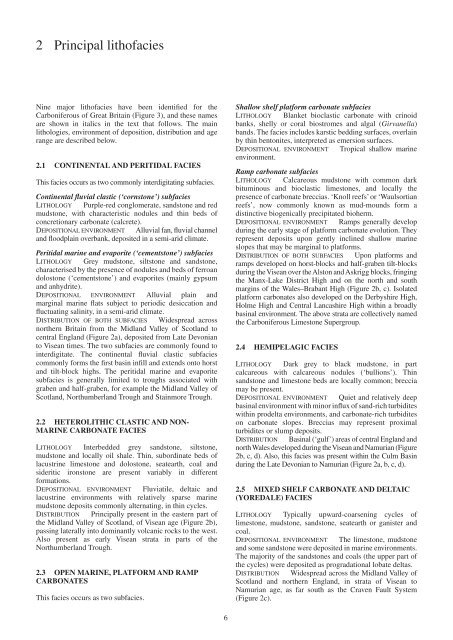Lithostratigraphical framework for Carboniferous successions of ...
Lithostratigraphical framework for Carboniferous successions of ...
Lithostratigraphical framework for Carboniferous successions of ...
You also want an ePaper? Increase the reach of your titles
YUMPU automatically turns print PDFs into web optimized ePapers that Google loves.
2 principal lith<strong>of</strong>acies<br />
Nine major lith<strong>of</strong>acies have been identified <strong>for</strong> the<br />
<strong>Carboniferous</strong> <strong>of</strong> Great Britain (Figure 3), and these names<br />
are shown in italics in the text that follows. The main<br />
lithologies, environment <strong>of</strong> deposition, distribution and age<br />
range are described below.<br />
2.1 CONTINENTAL AND PERITIDAL FACIES<br />
This facies occurs as two commonly interdigitating subfacies.<br />
Continental fluvial clastic (‘cornstone’) subfacies<br />
Lithology purple-red conglomerate, sandstone and red<br />
mudstone, with characteristic nodules and thin beds <strong>of</strong><br />
concretionary carbonate (calcrete).<br />
depositional environment alluvial fan, fluvial channel<br />
and floodplain overbank, deposited in a semi-arid climate.<br />
Peritidal marine and evaporite (‘cementstone’) subfacies<br />
Lithology Grey mudstone, siltstone and sandstone,<br />
characterised by the presence <strong>of</strong> nodules and beds <strong>of</strong> ferroan<br />
dolostone (‘cementstone’) and evaporites (mainly gypsum<br />
and anhydrite).<br />
depositional environment alluvial plain and<br />
marginal marine flats subject to periodic desiccation and<br />
fluctuating salinity, in a semi-arid climate.<br />
distribution <strong>of</strong> both subfacies widespread across<br />
northern Britain from the midland valley <strong>of</strong> scotland to<br />
central england (Figure 2a), deposited from Late devonian<br />
to visean times. The two subfacies are commonly found to<br />
interdigitate. The continental fluvial clastic subfacies<br />
commonly <strong>for</strong>ms the first basin infill and extends onto horst<br />
and tilt-block highs. The peritidal marine and evaporite<br />
subfacies is generally limited to troughs associated with<br />
graben and half-graben, <strong>for</strong> example the midland valley <strong>of</strong><br />
scotland, Northumberland Trough and stainmore Trough.<br />
2.2 HETEROLITHIC CLASTIC AND NON-<br />
MARINE CARBONATE FACIES<br />
Lithology interbedded grey sandstone, siltstone,<br />
mudstone and locally oil shale. Thin, subordinate beds <strong>of</strong><br />
lacustrine limestone and dolostone, seatearth, coal and<br />
sideritic ironstone are present variably in different<br />
<strong>for</strong>mations.<br />
depositional environment Fluviatile, deltaic and<br />
lacustrine environments with relatively sparse marine<br />
mudstone deposits commonly alternating, in thin cycles.<br />
distribution principally present in the eastern part <strong>of</strong><br />
the midland valley <strong>of</strong> scotland, <strong>of</strong> visean age (Figure 2b),<br />
passing laterally into dominantly volcanic rocks to the west.<br />
also present as early visean strata in parts <strong>of</strong> the<br />
Northumberland Trough.<br />
2.3 OPEN MARINE, PLATFORM AND RAMP<br />
CARBONATES<br />
This facies occurs as two subfacies.<br />
6<br />
Shallow shelf plat<strong>for</strong>m carbonate subfacies<br />
Lithology Blanket bioclastic carbonate with crinoid<br />
banks, shelly or coral biostromes and algal (Girvanella)<br />
bands. The facies includes karstic bedding surfaces, overlain<br />
by thin bentonites, interpreted as emersion surfaces.<br />
depositional environment Tropical shallow marine<br />
environment.<br />
Ramp carbonate subfacies<br />
Lithology Calcareous mudstone with common dark<br />
bituminous and bioclastic limestones, and locally the<br />
presence <strong>of</strong> carbonate breccias. ‘Knoll reefs’ or ‘waulsortian<br />
reefs’, now commonly known as mud-mounds <strong>for</strong>m a<br />
distinctive biogenically precipitated bioherm.<br />
depositional environment Ramps generally develop<br />
during the early stage <strong>of</strong> plat<strong>for</strong>m carbonate evolution. They<br />
represent deposits upon gently inclined shallow marine<br />
slopes that may be marginal to plat<strong>for</strong>ms.<br />
distribution <strong>of</strong> both subfacies upon plat<strong>for</strong>ms and<br />
ramps developed on horst-blocks and half-graben tilt-blocks<br />
during the visean over the alston and askrigg blocks, fringing<br />
the manx-Lake district High and on the north and south<br />
margins <strong>of</strong> the wales–Brabant High (Figure 2b, c). isolated<br />
plat<strong>for</strong>m carbonates also developed on the derbyshire High,<br />
Holme High and Central Lancashire High within a broadly<br />
basinal environment. The above strata are collectively named<br />
the <strong>Carboniferous</strong> Limestone supergroup.<br />
2.4 HEMIPELAGIC FACIES<br />
Lithology dark grey to black mudstone, in part<br />
calcareous with calcareous nodules (‘bullions’). Thin<br />
sandstone and limestone beds are locally common; breccia<br />
may be present.<br />
depositional environment Quiet and relatively deep<br />
basinal environment with minor influx <strong>of</strong> sand-rich turbidites<br />
within prodelta environments, and carbonate-rich turbidites<br />
on carbonate slopes. Breccias may represent proximal<br />
turbidites or slump deposits.<br />
distribution Basinal (‘gulf’) areas <strong>of</strong> central england and<br />
north wales developed during the visean and Namurian (Figure<br />
2b, c, d). also, this facies was present within the Culm Basin<br />
during the Late devonian to Namurian (Figure 2a, b, c, d).<br />
2.5 MIXED SHELF CARBONATE AND DELTAIC<br />
(YOREDALE) FACIES<br />
Lithology Typically upward-coarsening cycles <strong>of</strong><br />
limestone, mudstone, sandstone, seatearth or ganister and<br />
coal.<br />
depositional environment The limestone, mudstone<br />
and some sandstone were deposited in marine environments.<br />
The majority <strong>of</strong> the sandstones and coals (the upper part <strong>of</strong><br />
the cycles) were deposited as progradational lobate deltas.<br />
distribution widespread across the midland valley <strong>of</strong><br />
scotland and northern england, in strata <strong>of</strong> visean to<br />
Namurian age, as far south as the Craven Fault system<br />
(Figure 2c).

















